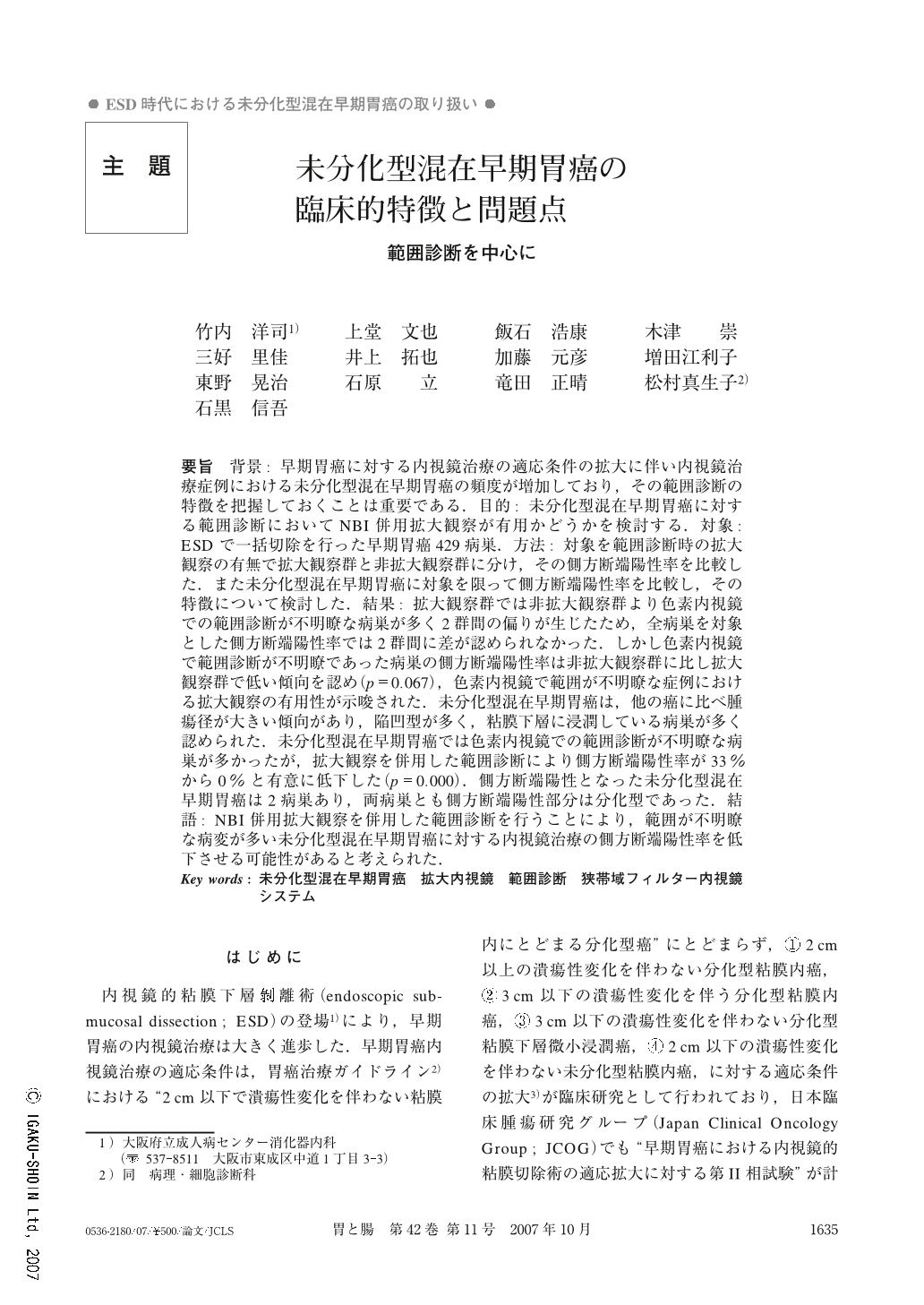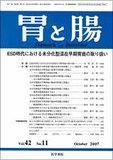Japanese
English
- 有料閲覧
- Abstract 文献概要
- 1ページ目 Look Inside
- 参考文献 Reference
- サイト内被引用 Cited by
要旨 背景:早期胃癌に対する内視鏡治療の適応条件の拡大に伴い内視鏡治療症例における未分化型混在早期胃癌の頻度が増加しており,その範囲診断の特徴を把握しておくことは重要である.目的:未分化型混在早期胃癌に対する範囲診断においてNBI併用拡大観察が有用かどうかを検討する.対象:ESDで一括切除を行った早期胃癌429病巣.方法:対象を範囲診断時の拡大観察の有無で拡大観察群と非拡大観察群に分け,その側方断端陽性率を比較した.また未分化型混在早期胃癌に対象を限って側方断端陽性率を比較し,その特徴について検討した.結果:拡大観察群では非拡大観察群より色素内視鏡での範囲診断が不明瞭な病巣が多く2群間の偏りが生じたため,全病巣を対象とした側方断端陽性率では2群間に差が認められなかった.しかし色素内視鏡で範囲診断が不明瞭であった病巣の側方断端陽性率は非拡大観察群に比し拡大観察群で低い傾向を認め(p=0.067),色素内視鏡で範囲が不明瞭な症例における拡大観察の有用性が示唆された.未分化型混在早期胃癌は,他の癌に比べ腫瘍径が大きい傾向があり,陥凹型が多く,粘膜下層に浸潤している病巣が多く認められた.未分化型混在早期胃癌では色素内視鏡での範囲診断が不明瞭な病巣が多かったが,拡大観察を併用した範囲診断により側方断端陽性率が33%から0%と有意に低下した(p=0.000).側方断端陽性となった未分化型混在早期胃癌は2病巣あり,両病巣とも側方断端陽性部分は分化型であった.結語:NBI併用拡大観察を併用した範囲診断を行うことにより,範囲が不明瞭な病変が多い未分化型混在早期胃癌に対する内視鏡治療の側方断端陽性率を低下させる可能性があると考えられた.
Background: Endoscopic submucosal dissection (ESD) allows the resection of larger lesions than in the past. According to expansion of the criteria for endoscopic treatment of early gastric cancer (EGC), the incidence of mixed (involving differentiated and undifferentiated) type EGC is increasing in the patients resected by ESD. We should know about the characteristics and problems in the pretreatment assessment of tumor extent in mixed type EGC.
Objective: To investigate the efficacy of magnifying endoscopy with narrow band imaging (NBI) for pretreatment assessment of tumor extent for mixed type EGC.
Materials: 429 EGCs resected en bloc by ESD.
Interventions: We compared the incidence of lateral margin positive resection in the non-magnifying endoscopy group and the magnifying endoscopy group. We also investigated characteristics and the usefulness of magnifying endoscopy for pretreatment assessment of tumor extent in mixed type EGC.
Results: There was no significant difference between the two groups as regards incidence of lateral margin positive resection, because of allocation bias. Pretreatment assessment using magnifying endoscopy with NBI is efficacious for decreasing the incidence of lateral margin positive resection in EGC with unclear margin diagnosed by chromoendoscopy. Mixed type EGC was relatively larger than non-mixed type EGC, and was comprised mainly of depressed type cancers invading to the submucosal layer. Based on chromoendoscopy, mixed type EGC often had unclear margins. Magnifying endoscopy using NBI can decrease the incidence of lateral margin positive resection in mixed type EGC.
Conclusion: Magnifying endoscopy with NBI used in pretreatment assessment of tumor extent for mixed type EGC can decrease the incidence of lateral margin resection.

Copyright © 2007, Igaku-Shoin Ltd. All rights reserved.


